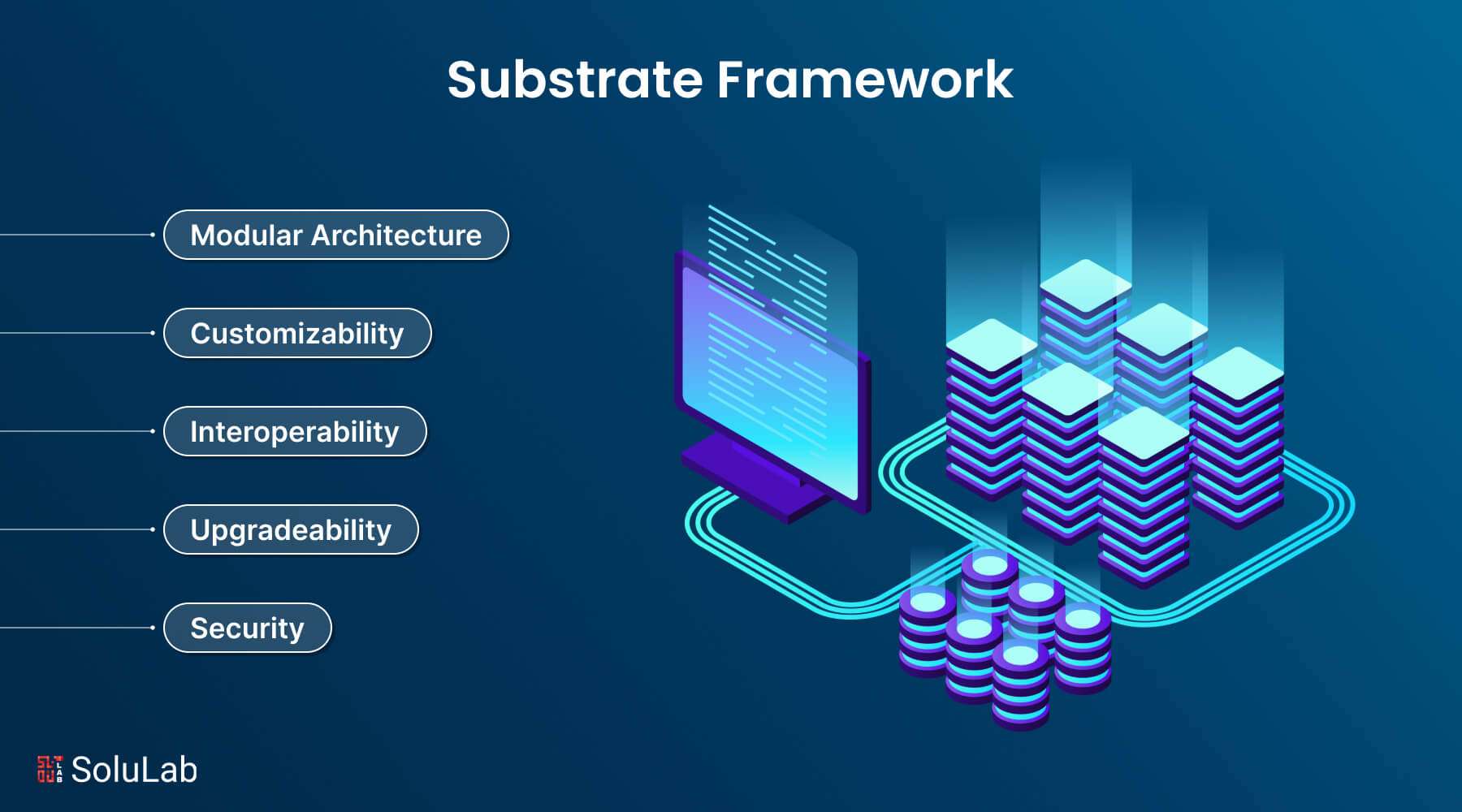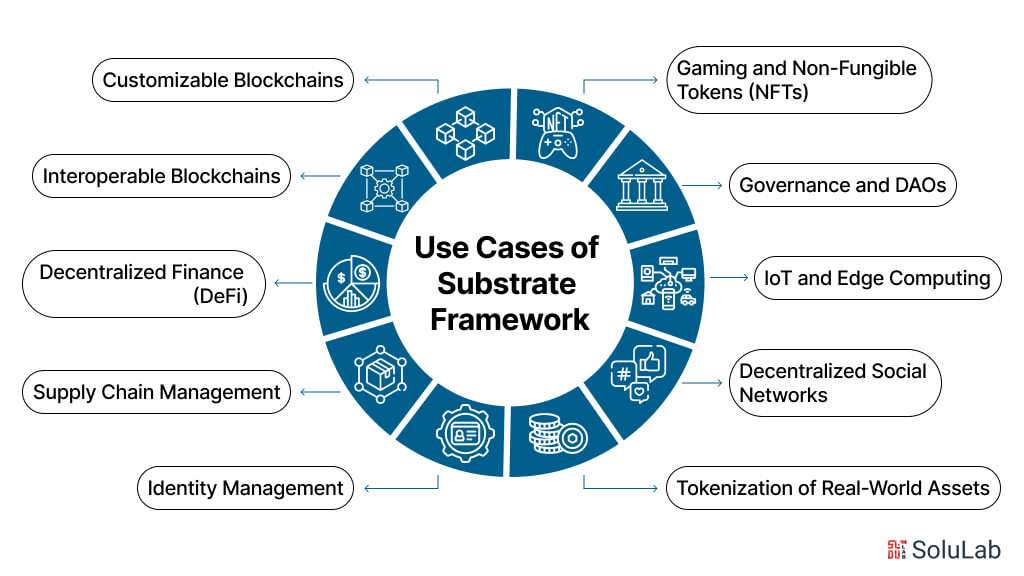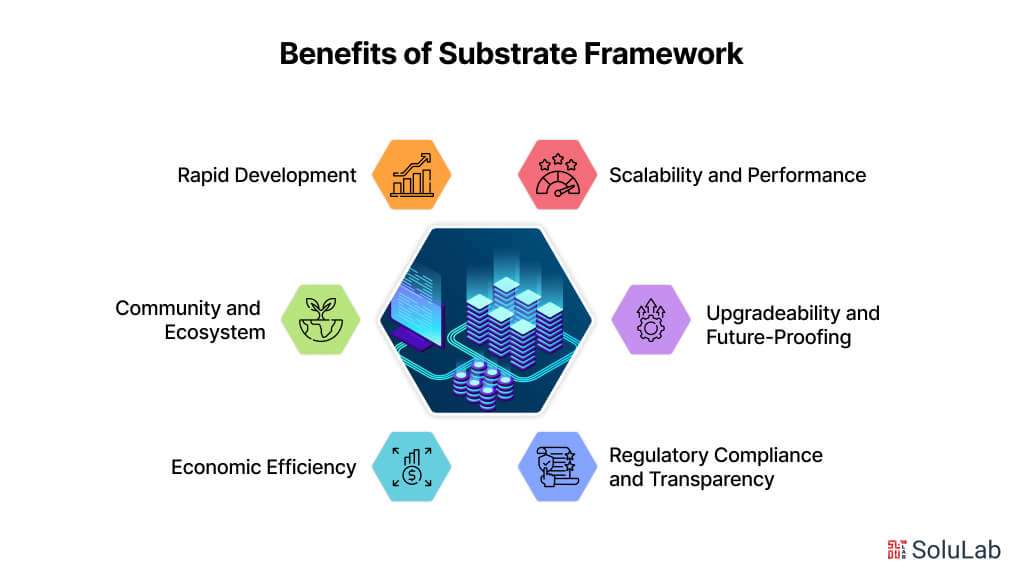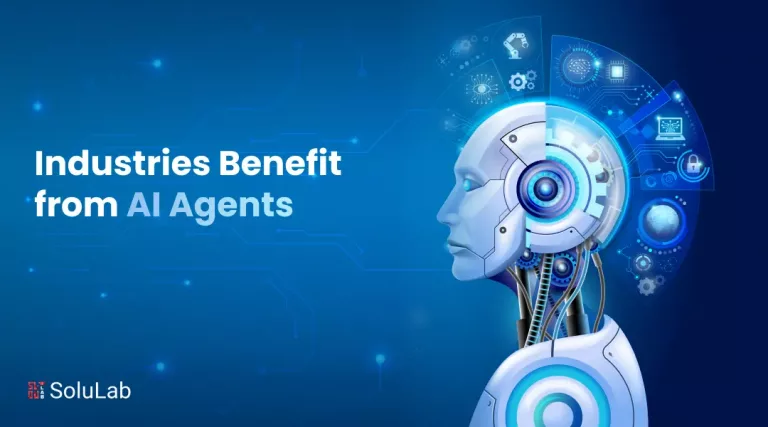
Blockchain technology has introduced transparency, decentralization, and immutability, upending established corporate practices. On the other hand, creating a blockchain network from scratch can be difficult and time-consuming. A framework called Substrate Blockchain is designed to make the process of creating personalized blockchain networks easier. We will cover all you need to know about Substrate Blockchain in this blog, including its use cases, advantages, features, development process, and more.
What is Substrate?
Substrate Blockchain Framework is a heat-powered toolbox designed to assist people in creating blockchains with their own unique environments. Because developers may make use of these features to create blockchains from the ground up or create specialized applications using the current blockchain technology for their particular purposes, there is a good chance that the required degree of sustainability will be attained.
Substrate Chain maximizes the degree of infrastructure provided by the Substrate. It serves as the backend and helps a lot of people on a daily basis with the creation of dApps, cryptocurrency, and blockchain-related solutions. Within the blockchain ecosystem, Substrate fosters innovation and independence by allowing developers the freedom to create and communicate consensus processes, governance models, and economic frameworks without interference from outside parties.
Substrate Blockchain has become rather popular in the blockchain community since its 2019 introduction. More than 200 blockchain applications, including as Polkadot, Kusama, and Acala, are constructed on Substrate. Built on Substrate, Polkadot is a blockchain network with a market valuation of approximately $60 billion as of February 2023. This demonstrates the growing funding and demand for substrate blockchain development initiatives.
Features Of Substrate Blockchain Framework
Here are some of the features of substrate blockchain framework:
- Modular Architecture: The design of the substrate is modular. Its composition resembles construction pieces. Developers may easily add or change out components. This adds stability to the system. It enhances the development process.
- Customizability: Substrate is comparable to a large toolbox full of options. To develop their protocols, developers experiment and make adjustments. They choose governance rules, token economics, and consensus algorithms, for example. This adaptability enables us to accurately modify the blockchain. It serves the intended objective and becomes helpful.
- Interoperability: It is a characteristic of a substrate. Smooth cross-chain communication channels are made possible by it. An avenue for asset transfers is made possible by this interconnectedness. As so, the blockchain ecosystem gains a new dimension.
- Upgradeability: For Substrate, upgradeability is crucial. It guarantees that blockchain systems may advance over time to maintain security and error-free operation. Substrate enables trouble-free, seamless upgrades to new protocol versions as necessary. This characteristic contributes to the durability and applicability of blockchain networks. Crucially, it also keeps them from becoming outdated.
- Security: Substrate Technology places a high premium on security. It contains sophisticated features to defend against frequent weaknesses and assaults. Substrate-based blockchain networks have the advantage of strong cryptography and safe coding techniques. This gives them an overall safe foundation.
Use Cases of Substrate Framework

The Substrate blockchain framework offers a versatile platform for developers to create tailored solutions across various industries. With its modular architecture and flexible design, Substrate enables the development of custom blockchain applications to address diverse use cases. Below are several substrate blockchain use cases in different domains:
1. Customizable Blockchains: Substrate allows developers to create customized blockchains tailored to specific use cases such as supply chain management, decentralized finance (DeFi), identity verification, gaming, and more. This flexibility enables developers to build blockchain solutions that meet the unique requirements of different industries.
2. Interoperable Blockchains: Substrate enables the creation of interoperable blockchains that can communicate and share data with each other. This is particularly useful in scenarios where multiple blockchain networks need to interact, such as cross-chain asset transfers, decentralized exchanges (DEXs), or multi-chain applications.
3. Decentralized Finance (DeFi): Substrate can be used to build various DeFi applications including decentralized exchanges, lending platforms, stablecoins, asset management tools, and more. Developers can leverage Substrate’s modular architecture to create composable financial primitives and build complex financial products and services.
Related: Defi- The Influensive Trend in Blockchain- A Complete Guide
4. Supply Chain Management: Substrate can be utilized to create transparent and traceable supply chain management solutions. By recording every step of the supply chain on a blockchain, stakeholders can verify the authenticity and origin of products, reduce counterfeiting, improve transparency, and streamline logistics.
5. Identity Management: Substrate can power decentralized identity management solutions where users have control over their personal data and can selectively share it with trusted parties. This can be particularly useful in scenarios such as self-sovereign identity, KYC/AML compliance, access management, and secure authentication.
6. Gaming and Non-Fungible Tokens (NFTs): Substrate can be used to build blockchain-based gaming platforms and marketplaces for non-fungible tokens (NFTs). Developers can create unique digital assets, such as in-game items, collectibles, and artwork, and enable users to buy, sell, and trade them securely on the blockchain.
7. Governance and DAOs: Substrate provides tools for creating decentralized autonomous organizations (DAOs) and implementing on-chain governance mechanisms. This enables communities to govern their blockchain networks, make decisions collectively, and manage protocol upgrades, funding allocations, and other governance processes in a transparent and decentralized manner.
8. IoT and Edge Computing: Substrate can be used to build decentralized IoT (Internet of Things) networks where devices interact and transact autonomously without the need for centralized intermediaries. By combining blockchain technology with edge computing, developers can create secure and scalable IoT solutions for various applications including smart cities, supply chain monitoring, environmental sensing, and more.
9. Decentralized Social Networks: Substrate can power decentralized social networks where users have full control over their data and interactions. By leveraging blockchain technology, developers can create platforms where users can connect, share content, and monetize their contributions without relying on centralized intermediaries. Substrate’s modular architecture allows for the implementation of features such as content moderation, reputation systems, micro-payments, and privacy-enhancing tools, enabling the creation of vibrant and censorship-resistant social networks.
10. Tokenization of Real-World Assets: Substrate can facilitate the tokenization of real-world assets such as real estate, stocks, commodities, and intellectual property rights. By representing these assets as digital tokens on a blockchain, ownership can be easily transferred, fractionalized, and traded in a transparent and efficient manner. Substrate’s smart contract capabilities and interoperability features enable developers to create asset tokenization platforms that comply with regulatory requirements, facilitate liquidity, and unlock new investment opportunities for a wide range of assets.
The Substrate Blockchain Development Process
Before diving into the development process, developers typically establish their environment by learning Rust, the programming language behind Substrate, and setting up their development environment. Here is a step-by-step process of the substrate blockchain development.
- Setting Up the Development Environment: To begin, developers had to learn Rust, the programming language that powers Substrate, and set up their environment. The simple setup procedure of Substrate is a major benefit over Ethereum. Time is saved and friction is decreased for developers using the Substrate platform thanks to this optimized procedure.
- Project Launch: Developers may initiate projects and set the fundamental structure and configuration files required for the blockchain development process by using the Substrate command-line interface (CLI) to begin working on a new project.
- Customization: By selecting important elements like as the consensus process, token economics, governance structures, and more, developers may modify the Substrate project to meet their unique needs. It’s important to note that Substrate’s modular architecture enables smooth integration with third-party modules and features via an easy-to-use interface.
- Runtime Development: The most crucial element in the process of developing runtime logic is the open history of Substrate blockchain development, which involves creating expensive code in the Rust programming language. The laws and ethics of the blockchain, such as how transactions are processed, how nations change often, and how smart agreements are implemented, are outlined by developers.
- Testing and Debugging: Substrate’s own integrated Testing Framework is used to generalize this implementation below it. In order to preserve the blockchain’s validity and dependability, unit testing, integration testing, and stress testing are used. As a result, there will be a high and real chance of investment, trust, and confidence in the chain’s functionality.
- Deployment: After undergoing this comprehensive examination, the Substrate-powered blockchain community is deployed either in the test net or in a selected client. The developers then deploy the blockchain into a public community for production usage as soon as the functionality and performance of the blockchain creation are completed.
Practical Applications of the Substrate Framework
The Substrate blockchain framework offers a versatile platform for building customized blockchain solutions across various industries. Its modular architecture, flexibility, and ease of development make it well-suited for a wide range of practical applications:
- Polkadot (DOT): The base A system that functions as a multi-chain protocol in Polkadot is demonstrated using blockchain. One of the most obvious advantages of this multichain protocol is interchain connection. A dynamic and pluralistic ecosystem may reproduce itself with ease when Polkadot, based on Substrate, serves as the foundation for the seamless movement of assets and data across several chains.
- Kusama (KSM): Often referred to as the “canary network” for Polkadot, Kusama serves as a live testing ground for new features and upgrades before they are deployed on Polkadot. Its experimental nature attracts technological innovators and reformers who actively engage in testing and refining substrate-based use cases and properties. This collaborative environment fosters rapid iteration and development, pushing the boundaries of what is possible with the Substrate framework.
- Chainlink (LINK): Chainlink uses the Substrate Blockchain Framework to provide smart contract oracle replies on a stable basis. Because it leverages Substrate’s modular architecture to supply blockchain structures and packaging with a custom-designed oracle to be able to accommodate the different demands and smoothly integrate, Chainlink is sufficiently versatile in contrast to the contrary oracle responses.
- Moonbeam: A Moonbeam proposal exemplifies Substrate’s versatility and shows how it may be used to create an Ethereum-compatible smart contract platform. Based mostly on Substrate, Moonbeam provides developers with an Ethereum-like environment that makes it simple to implement smart contracts and reap the benefits of increased scalability and performance in general through the use of Substrate’s underlying generation.
- Acala Network: Utilizing Substrate’s modular framework, Acala Network, a financial platform built on top of decentralized finance (DeFi), provides a range of economic solutions through robust cash, liquidity, and decentralized lending. Acala settles around Substrate, resulting in the delivery of user-friendly, safe, and effective DeFi protocols.
- Litentry: Litentry is a decentralized identity assembly system that leverages the Substrate Blockchain Framework and is the way the digital identity will be better in terms of self-governance. By utilizing Substrate’s capabilities, Litentry puts together an identity solution for clients that allows them to fully control their statistics and navigate a variety of structures and programs at their own privacy level.
Benefits of Substrate Framework

The Substrate blockchain framework offers several key benefits that make it an attractive choice for developers and blockchain enthusiasts alike:
1. Rapid Development: Substrate’s developer-friendly tools, including the Substrate command-line interface (CLI) and the Substrate Runtime Module Library (SRML), streamline the development process and reduce time-to-market for blockchain applications. Developers can quickly prototype, test, and deploy their projects, thanks to Substrate’s comprehensive documentation and supportive community.
2. Scalability and Performance: Substrate is built with scalability in mind, utilizing technologies such as sharding and parallel execution to improve the throughput and performance of blockchain networks. By leveraging Substrate’s scalable architecture, developers can build high-performance applications capable of handling large transaction volumes and supporting growing user bases.
3. Community and Ecosystem: Substrate benefits from a vibrant and active community of developers, contributors, and enthusiasts who collaborate on improving and expanding the framework. The growing ecosystem of Substrate-based projects, tools, and services provides developers with a rich set of resources and opportunities for collaboration, further accelerating innovation in the blockchain space.
4. Upgradeability and Future-Proofing: Substrate provides built-in mechanisms for on-chain upgrades and runtime module changes, enabling developers to evolve their blockchain networks over time without requiring hard forks or disruptions to network operations. This upgradeability ensures that blockchain applications built on Substrate can adapt to changing requirements, technological advancements, and community feedback, future-proofing their functionality and longevity.
5. Economic Efficiency: Substrate’s modular design and lightweight architecture result in lower resource requirements for running blockchain nodes, making it more cost-effective compared to other blockchain frameworks. This economic efficiency reduces barriers to entry for developers and validators, democratizing access to blockchain technology and fostering broader participation in the ecosystem.
6. Regulatory Compliance and Transparency: Substrate supports the implementation of regulatory compliance features, such as identity verification, transaction monitoring, and auditability, to ensure adherence to legal and regulatory requirements. By promoting transparency and accountability, Substrate helps foster trust and confidence among users, investors, and regulators, facilitating the adoption of blockchain technology in regulated industries and jurisdictions.
Concluding Thoughts
In a nutshell, Substrate is a crucial blockchain development milestone that blockchain solution development firms should not overlook. This is giving programmers a plethora of options for safe, adaptable, and scalable blockchain applications. Because of its special qualities that enable the creation of tailored chains meant to address real-world issues across several industries, the substrate is regarded as a top platform. Blockchain development firms set the stage for the disclosure of blockchain capabilities to become a reality by adopting substrates, mastering them, and then refining their implementations. Thus, it marks the beginning of a time when technological advancements and discoveries are controlled by the people.
As a blockchain development company, SoluLab leverages its expertise in the Substrate framework to empower businesses in realizing their blockchain ambitions. With a dedicated team of experienced developers proficient in Rust programming language and Substrate development, SoluLab offers end-to-end solutions tailored to clients’ specific requirements. From conceptualization and design to development, deployment, and maintenance, SoluLab guides clients through every stage of their blockchain journey, ensuring seamless integration with existing systems and processes. Whether it’s building custom blockchain applications, interoperable networks, or decentralized finance (DeFi) platforms, SoluLab combines technical excellence with industry insights to deliver innovative and scalable solutions. Contact us today to explore how SoluLab can help unlock the full potential of blockchain technology for your business.
FAQs
1. What is the Substrate framework?
The Substrate framework is a modular, open-source blockchain development framework created by Parity Technologies. It provides developers with a flexible and customizable toolkit for building blockchain networks tailored to specific use cases and requirements.
2. What programming languages are used in Substrate development?
Substrate development primarily involves the use of the Rust programming language. Rust is chosen for its performance, safety, and suitability for building high-quality blockchain applications. Additionally, Substrate provides support for writing smart contracts in languages like Ink!, enabling developers to implement custom logic on their blockchain networks.
3. How does Substrate differ from other blockchain frameworks?
Substrate stands out from other blockchain frameworks due to its modular architecture, which allows developers to easily customize and extend the functionality of their blockchain networks. It also offers built-in support for interoperability, upgradeability, and on-chain governance, making it well-suited for building scalable, interoperable, and future-proof blockchain applications.
4. What kind of projects can be built with Substrate?
Substrate can be used to build a wide range of blockchain projects, including decentralized finance (DeFi) platforms, supply chain management systems, identity verification solutions, gaming platforms, and more. Its flexibility and versatility make it suitable for both public and private blockchain networks, catering to diverse use cases across various industries.
5. Is Substrate suitable for enterprise-level blockchain development?
Yes, Substrate is suitable for enterprise-level blockchain development. It offers features such as scalability, interoperability, and regulatory compliance, making it an ideal choice for businesses looking to deploy blockchain solutions at scale. Additionally, Substrate’s robust security features and developer-friendly tools ensure the reliability and stability of enterprise-grade blockchain applications.






